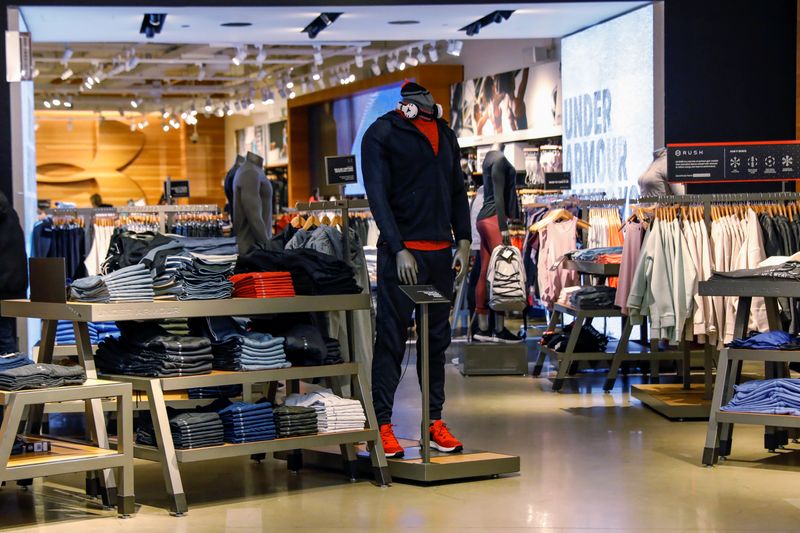Goldman refreshes its gold stocks outlook for 2025
On Tuesday, Under Armour (NYSE:UA), Inc. (NYSE:UAA), currently trading at $6.21, received a reaffirmed Market Perform rating from Raymond (NSE:RYMD) James, following the company’s fiscal fourth quarter 2025 earnings report. According to InvestingPro data, the stock has shown significant momentum with an 8.95% return over the last week, though it remains undervalued based on Fair Value analysis. The sportswear company’s earnings per share (EPS) aligned with expectations at -$0.08, while revenue decline was slightly better than anticipated, dropping 11.4% compared to the projected 11.5% by Raymond James and 12.5% by consensus.
Under Armour’s gross margin improved, up by 165 basis points year-over-year to 46.7%, exceeding both Raymond James’ forecast of a 75 basis point increase and the street’s 90 basis point expectation. However, the company’s selling, general, and administrative (SG&A) expenses grew by 7.5%, surpassing predictions from Raymond James and consensus, which were 5.5% and 4.4%, respectively. Consequently, the earnings before interest and taxes (EBIT) margin was nearly on target, down 707 basis points year-over-year to -3.0%.
By segment, North American sales decreased by 11%, which was a better outcome than the 14.5% decrease anticipated by both Raymond James and street estimates. Nonetheless, the Asia-Pacific region, a key area for long-term strategic growth, saw a concerning 27% revenue contraction, which was significantly worse than the 12% and 22% declines expected by Raymond James and consensus, respectively. Direct-to-consumer (DTC) sales also fell more sharply than anticipated, at a 15% decline due to efforts to reduce digital promotions, with e-commerce dropping by 27%. This was somewhat balanced by a 10% decrease in wholesale, against the forecasted 12% by Raymond James and 12.6% by consensus. Footwear revenue saw a more pronounced reduction than apparel.
Amidst trade and macroeconomic uncertainties, Under Armour has provided guidance for the first quarter of fiscal 2026 that is modestly above expectations at the midpoint, reflecting a revenue outlook that falls below expectations, while gross margin percentage and EBIT dollar guidance are above consensus. Raymond James’ initial impression of the fiscal fourth quarter 2025 results is that Under Armour remains a company in transition, with revenues continuing to contract as it strives to enhance its product offerings and brand image, which is leading to improved profitability. InvestingPro analysis reveals analyst targets ranging from $4 to $14.50 per share, with consensus suggesting potential upside. For deeper insights into Under Armour’s financial health, valuation metrics, and growth prospects, investors can access the comprehensive Pro Research Report, available exclusively to InvestingPro subscribers.
In other recent news, Under Armour reported a fourth-quarter earnings per share (EPS) of ($0.08), which matched consensus expectations, while sales exceeded expectations with an 11% improvement over the anticipated 12.5% decline. The company’s gross margin increased by 170 basis points, surpassing the predicted 90 basis point rise, although this was offset by a 7.5% increase in selling, general, and administrative expenses. Citi analysts maintained a Neutral rating for Under Armour with a $6.00 price target, noting the company’s challenges with brand positioning and momentum. Looking ahead, Under Armour’s management has guided a 4-5% decline in first-quarter sales, which is more pessimistic than the 1% drop expected by analysts, but EPS guidance is slightly more optimistic at $0.01 to $0.03.
Moody’s Ratings downgraded Under Armour’s corporate family rating to Ba3 from Ba2, with a negative outlook, due to expectations of decreased earnings over the next 12-18 months. This downgrade reflects concerns over weakened consumer discretionary spending and increased tariff costs, which may hinder the company’s turnaround strategy. Under Armour’s liquidity rating was also reduced to SGL-3, although the company is expected to maintain adequate liquidity with solid cash balances and access to a $1.1 billion revolver. Despite the challenges, the company’s relatively low level of funded debt offers some credit support, though uncertainties around tariffs remain a concern for future earnings and cash flow.
This article was generated with the support of AI and reviewed by an editor. For more information see our T&C.
